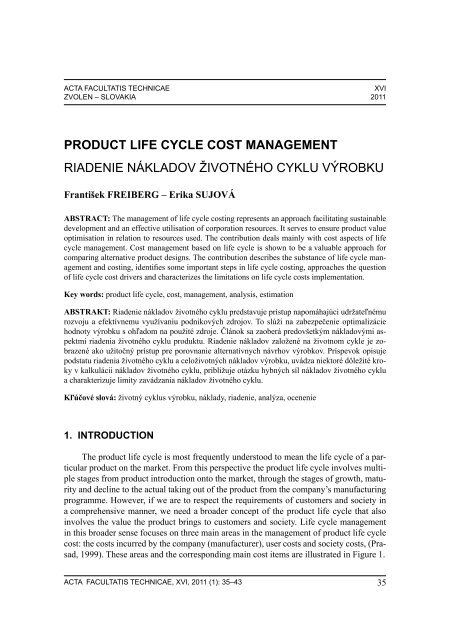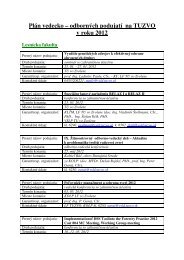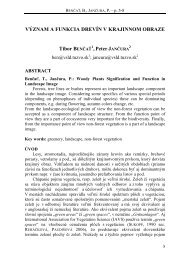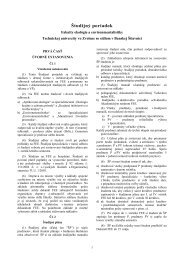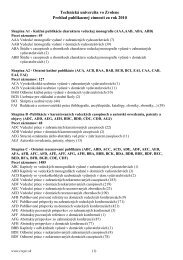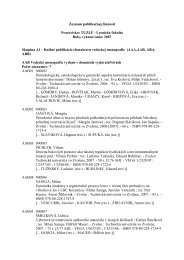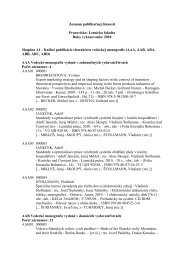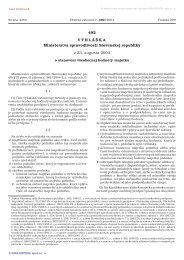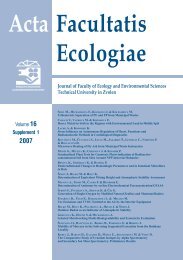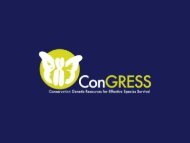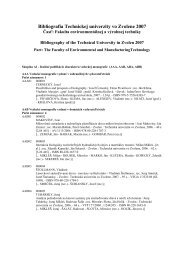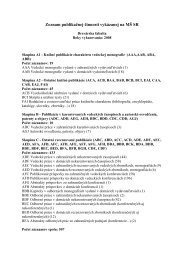product life cycle cost management riadenie nákladov životného ...
product life cycle cost management riadenie nákladov životného ...
product life cycle cost management riadenie nákladov životného ...
You also want an ePaper? Increase the reach of your titles
YUMPU automatically turns print PDFs into web optimized ePapers that Google loves.
ACTA FACULTATIS TECHNICAEXVIZVOLEN – SLOVAKIA 2011PRODUCT LIFE CYCLE COST MANAGEMENTRIADENIE NÁKLADOV ŽIVOTNÉHO CYKLU VÝROBKUFrantišek FREIBERG – Erika SUJOVÁABSTRACT: The <strong>management</strong> of <strong>life</strong> <strong>cycle</strong> <strong>cost</strong>ing represents an approach facilitating sustainabledevelopment and an effective utilisation of corporation resources. It serves to ensure <strong>product</strong> valueoptimisation in relation to resources used. The contribution deals mainly with <strong>cost</strong> aspects of <strong>life</strong><strong>cycle</strong> <strong>management</strong>. Cost <strong>management</strong> based on <strong>life</strong> <strong>cycle</strong> is shown to be a valuable approach forcomparing alternative <strong>product</strong> designs. The contribution describes the substance of <strong>life</strong> <strong>cycle</strong> <strong>management</strong>and <strong>cost</strong>ing, identifies some important steps in <strong>life</strong> <strong>cycle</strong> <strong>cost</strong>ing, approaches the questionof <strong>life</strong> <strong>cycle</strong> <strong>cost</strong> drivers and characterizes the limitations on <strong>life</strong> <strong>cycle</strong> <strong>cost</strong>s implementation.Key words: <strong>product</strong> <strong>life</strong> <strong>cycle</strong>, <strong>cost</strong>, <strong>management</strong>, analysis, estimationABSTRAKT: Riadenie nákladov životného cyklu predstavuje prístup napomáhajúci udržateľnémurozvoju a efektívnemu využívaniu podnikových zdrojov. To slúži na zabezpečenie optimalizáciehodnoty výrobku s ohľadom na použité zdroje. Článok sa zaoberá predovšetkým nákladovými aspektmiriadenia životného cyklu produktu. Riadenie nákladov založené na životnom cykle je zobrazenéako užitočný prístup pre porovnanie alternatívnych návrhov výrobkov. Príspevok opisujepodstatu riadenia životného cyklu a celoživotných nákladov výrobku, uvádza niektoré dôležité krokyv kalkulácii nákladov životného cyklu, približuje otázku hybných síl nákladov životného cyklua charakterizuje limity zavádzania nákladov životného cyklu.Kľúčové slová: životný cyklus výrobku, náklady, <strong>riadenie</strong>, analýza, ocenenie1. INTRODUCTIONThe <strong>product</strong> <strong>life</strong> <strong>cycle</strong> is most frequently understood to mean the <strong>life</strong> <strong>cycle</strong> of a particular<strong>product</strong> on the market. From this perspective the <strong>product</strong> <strong>life</strong> <strong>cycle</strong> involves multiplestages from <strong>product</strong> introduction onto the market, through the stages of growth, maturityand decline to the actual taking out of the <strong>product</strong> from the company’s manufacturingprogramme. However, if we are to respect the requirements of customers and society ina comprehensive manner, we need a broader concept of the <strong>product</strong> <strong>life</strong> <strong>cycle</strong> that alsoinvolves the value the <strong>product</strong> brings to customers and society. Life <strong>cycle</strong> <strong>management</strong>in this broader sense focuses on three main areas in the <strong>management</strong> of <strong>product</strong> <strong>life</strong> <strong>cycle</strong><strong>cost</strong>: the <strong>cost</strong>s incurred by the company (manufacturer), user <strong>cost</strong>s and society <strong>cost</strong>s, (Prasad,1999). These areas and the corresponding main <strong>cost</strong> items are illustrated in Figure 1.ACTA FACULTATIS TECHNICAE, XVI, 2011 (1): 35–4335
The objective of <strong>product</strong> <strong>life</strong> <strong>cycle</strong> <strong>cost</strong> <strong>management</strong> is to maximise the value (benefits)of a <strong>product</strong> while controlling the <strong>cost</strong>s on the part of the manufacturer, user andsociety. The manufacturer’s <strong>cost</strong>s include the <strong>cost</strong>s of activities carried out, for example,as part of <strong>product</strong> planning, design, development, assembly, distribution and servicing.These are all <strong>cost</strong>s incurred from the moment of a request for <strong>product</strong> delivery until themoment of dispatching the <strong>product</strong> to the customer. The user <strong>cost</strong>s entail the <strong>cost</strong>s ofactivities carried out by the user. They cover the period from delivering the <strong>product</strong> untiltermination of its economic <strong>life</strong> span. This may also include the recycling and disposal<strong>cost</strong>s that are paid by the user. Society <strong>cost</strong>s comprise the <strong>cost</strong>s that constitute a burden tosociety at the <strong>product</strong> manufacturing and use stages, particularly the <strong>cost</strong>s related to therecycling of materials and the impact of the manufacturing and use of the <strong>product</strong> on theenvironment.Conception Shipment Ownership níEndsCompanypodnikuUser uživatele <strong>cost</strong>s<strong>cost</strong>sspolečnostiSociety CostsGraveMarketingvývoj Designmontáž AssemblykontrolaQC / Inspectionkvalityvýroba Productiondistribuce Distributionzáruky WarantysLife-<strong>cycle</strong> servisServiceskladováníInventory StorageTransportationdopravaDisposal/recyclyngrecyklaceusage duesEnergy, materiál, Materialenergie,..Maitenance údržba...recyklace RecyclingPollution/znečištění Combustionmanipulace Packagings odpademWaste zdravotní HandlingrizikabezpečnostníHealth damagesrizikaSafety......NeedsDevelopment vývoj Dodání Delivery provoz Usage Dispozice Disposal recyklace RecyclingAbsorpce AbsorptionFig. 1 Areas of Life Cycle Cost Management2. THE IMPORTANCE OF AN ANALYSIS OF PRODUCT LIFE CYCLECOSTProduct <strong>life</strong> <strong>cycle</strong> <strong>cost</strong> analysis forms an important part of <strong>product</strong> <strong>life</strong> <strong>cycle</strong> <strong>management</strong>.This is a technique for comprehensive assessment of the <strong>product</strong> <strong>cost</strong>s from the<strong>product</strong> idea stage to termination of its <strong>life</strong> <strong>cycle</strong>. This makes it possible to analyse <strong>product</strong><strong>cost</strong>s throughout the various stages of its <strong>life</strong> span, as well as the interaction between the<strong>cost</strong> elements with a view to identify an optimal choice for the <strong>product</strong> variant in terms of<strong>cost</strong>. Incorporating <strong>life</strong> <strong>cycle</strong> <strong>cost</strong>s as a parameter into the <strong>product</strong> development process(systems, facilities, projects) facilitates the development of <strong>cost</strong>-effective <strong>product</strong>s that are36 ACTA FACULTATIS TECHNICAE, XVI, 2011 (1): 35–43
interesting for the buyer both in terms of the purchasing price and in terms of operationaland logistical <strong>cost</strong>s as well as recycling or disposal <strong>cost</strong>s.In the future manufacturers of machinery and equipment will have to assume a greaterdegree of responsibility for activities related to the <strong>life</strong> <strong>cycle</strong> of their <strong>product</strong>s, not onlyduring the manufacturing and sales stages but also during the stages following <strong>product</strong>delivery and installation. In a situation where the sum of operating, maintenance, redevelopment,repair and disposal <strong>cost</strong>s associated with some <strong>product</strong>s is often many timeshigher than the <strong>cost</strong> of procurement, a <strong>cost</strong> analysis targeted at <strong>product</strong> use is constantlygaining in importance.Product <strong>life</strong> <strong>cycle</strong> <strong>cost</strong> analysis is always needed where there are various problemsolving alternatives and a decision must be made as to which alternative is more favourable.The analysis may be used in many situations. For example, it may concern assessmentof possible ways of using the <strong>product</strong> in operation, maintenance policies and logisticssupport solutions, <strong>product</strong> design configurations, ways of <strong>product</strong> manufacturing, waysof <strong>product</strong> distribution and transport and ways of its disposal and recycling, (Fabricky1991).If <strong>product</strong> <strong>cycle</strong> <strong>cost</strong>s are to be used as a system development parameter, it is necessaryto design and implement a programme that would make it possible to define theactivities necessary for setting the <strong>cost</strong> objectives and their fulfilment. It is necessary toidentify who will carry out the analysis, who will be responsible for utilisation of theoutcomes of the <strong>product</strong> <strong>life</strong> <strong>cycle</strong> <strong>cost</strong> analysis, how the database for estimating <strong>product</strong><strong>life</strong> <strong>cycle</strong> <strong>cost</strong>s will be established and maintained, what will be the ways of reporting theresults of the analysis, how the necessary corrective measures will be initiated, etc.3. THE DATABASE FOR PRODUCT LIFE CYCLE COST ANALYSISOne of the key success factors in <strong>life</strong> <strong>cycle</strong> <strong>management</strong> is the availability of informationabout the technical, market and economic parameters of the <strong>product</strong> <strong>life</strong> <strong>cycle</strong>. Itis clear that there is commonly a mismatch between the information available and thatrequired. This gap between the need for information and its availability is the widest at theinitial stages of the <strong>product</strong> <strong>life</strong> <strong>cycle</strong>. The development of the difference between demandfor information about <strong>product</strong> <strong>life</strong> <strong>cycle</strong> and its availability in the course of the <strong>product</strong> <strong>life</strong><strong>cycle</strong> is well illustrated by Figure 2, (Westkaempfer, Niemann and Dauensteiner, 2001)and (Westkaempfer, 2002).The success of the <strong>product</strong> <strong>life</strong> <strong>cycle</strong> analysis depends on the availability of suitabledata concerning a range of areas and activities that relate to the <strong>product</strong> <strong>life</strong> <strong>cycle</strong>. Theseare, for example, data that are associated with <strong>product</strong> design and development, pre-manufacturingactivities, the manufacturing of the <strong>product</strong>, its use, maintenance, recyclingand disposal. Companies normally have various extensive <strong>cost</strong>-related data. However,their use for the <strong>life</strong> <strong>cycle</strong> analysis tends to be problematic. In most cases there is notthe required amount and structure of the data, they are not relevant or appropriate for theproblem being solved, and they are not comprehensive. It is also common for data to bemaintained in several isolated information systems without the possibility of their interconnectionat system level.ACTA FACULTATIS TECHNICAE, XVI, 2011 (1): 35–4337
Fig. 2 Demand for information about <strong>product</strong> <strong>life</strong> <strong>cycle</strong> in relation to availability of the informationHistorical data constitute a relatively accessible and important source of data for ananalysis and forecast of <strong>product</strong> <strong>life</strong> <strong>cycle</strong> <strong>cost</strong>s. However, even the possible ways ofusing historical data are often limited. The biggest problem is that there are not alwayshistorical data about a comparable <strong>product</strong> or its components. New <strong>product</strong>s are oftenmore efficient, of higher quality and more reliable, which understandably distinguishesthem from their predecessors in many respects – e. g. the <strong>cost</strong> structure, operating <strong>cost</strong>sand maintenance <strong>cost</strong>s.In addition to historical data, what is also indispensable is forecasts of future trendsconcerning technologies, materials, <strong>product</strong> components, operating strategies, market developmentand competition, research, anticipated demand, requirements of <strong>product</strong> users,etc. When developing special databases for <strong>product</strong> <strong>life</strong> <strong>cycle</strong> <strong>cost</strong> analyses it is necessaryto take account, above all, of data accessibility, serviceability of defined needs, adaptabilityto changed requirements, etc.3.1 Calculation of <strong>product</strong> <strong>life</strong> <strong>cycle</strong> <strong>cost</strong>sThe procedure for calculating <strong>product</strong> <strong>life</strong> <strong>cycle</strong> <strong>cost</strong>s is illustrated in Figure 3,(Woodward, 1997).Define the<strong>cost</strong> elementsof interestDefine the<strong>cost</strong>structureEstablish the<strong>cost</strong>estimationrelationshipsEstablishthe methodof <strong>life</strong> <strong>cycle</strong><strong>cost</strong>formulationProduct<strong>life</strong> <strong>cycle</strong><strong>cost</strong>sFig. 3 Product <strong>life</strong> <strong>cycle</strong> <strong>cost</strong>ing38 ACTA FACULTATIS TECHNICAE, XVI, 2011 (1): 35–43
The <strong>cost</strong> items we track include all <strong>cost</strong>s that arise from the instant of <strong>product</strong> conceptionuntil its disposal at the end of its <strong>life</strong> <strong>cycle</strong>. The <strong>cost</strong> items should be structured so asto facilitate identification of potential links between them with a view to identifying theappropriate level of <strong>product</strong> <strong>life</strong> <strong>cycle</strong> <strong>cost</strong>s. The <strong>cost</strong> item structure will always dependon the nature of the specific <strong>product</strong>. It should always allow for carrying out a <strong>product</strong> <strong>life</strong><strong>cycle</strong> <strong>cost</strong>s analysis. The objective of the <strong>cost</strong> estimation is to try to identify <strong>cost</strong> items asa function of one or more independent variables. The last stage of the <strong>cost</strong>ing procedureconsists in defining an approach to calculating <strong>life</strong> <strong>cycle</strong> <strong>cost</strong>s. For example, (Kaufman,1970) presents a method comprising eight steps:• Establishing the operating profile: description of the periodic <strong>cycle</strong> the <strong>product</strong> (e.g.a piece of manufacturing equipment) will go through. As part of this step the operatingmodes for the entire <strong>life</strong> span of the <strong>product</strong> are defined.• Establishing the utilisation factors: while the operating profile captures the proportionof time during which the equipment will be operating or not operating, utilisation factorsindicate the way in which the equipment will be functioning within the variousoperating modes (continuously, intermittently,…).• Identifying all the <strong>cost</strong> elements.• Determining the critical <strong>cost</strong> parameters: determining the parameters that affect theequipment’s <strong>life</strong> <strong>cycle</strong> <strong>cost</strong>s. For example, the time period between failures, repairs,overhauls, scheduled maintenance, etc.• Calculation of all <strong>cost</strong>s at current prices.• Increasing current <strong>cost</strong>s to accommodate inflation.• Discounting all <strong>cost</strong>s to the base period.• Summing up the discounted <strong>cost</strong>s.Another example of the structure and sequence of steps as part of <strong>product</strong> <strong>life</strong> <strong>cycle</strong> <strong>cost</strong>analysis may be found in (Wynholds and Scraft, 1997):• Developing a representative <strong>cost</strong> structure (identification of <strong>cost</strong> items).• Collection of data to support the <strong>cost</strong> structure.• Establishing appropriate connections for <strong>cost</strong> estimation for each <strong>cost</strong> component.• Developing a comprehensive <strong>cost</strong> model (<strong>life</strong> <strong>cycle</strong> <strong>cost</strong> calculation).• Testing and use of the model (carrying out a sensitivity analysis).3.2 The key influence of the design and development stageon <strong>product</strong> <strong>life</strong> <strong>cycle</strong> <strong>cost</strong>sThe greatest opportunity for reducing <strong>life</strong> <strong>cycle</strong> <strong>cost</strong>s and improving the <strong>product</strong> parametersand performance can be identified in the initial stages of the <strong>product</strong> <strong>life</strong> <strong>cycle</strong>(the design and development phase). The <strong>cost</strong>s incurred at this stage are not so high whencompared to the overall <strong>life</strong> <strong>cycle</strong> <strong>cost</strong>s of the <strong>product</strong>. However, decisions taken duringthis phase have a considerable impact on <strong>cost</strong>s during the manufacturing and operationalstages. At the manufacturing stage, and even more so at the operational stage, any modificationsand attempts to influence manufacturing and operating <strong>cost</strong>s are considerablylimited. This is well illustrated in Figure 4, (Wrobel and Laudanski, 2008).ACTA FACULTATIS TECHNICAE, XVI, 2011 (1): 35–4339
Life-Cycle Cost committed100%80%Costincurred66%KnowledgeEase of changeConceptual/preliminaryDetail design Production Product use/support/phaseout/disposalFig. 4 Incurred and planned expenditures along with know-howThe importance of the implementation of <strong>life</strong> <strong>cycle</strong> <strong>cost</strong> analysis at the stage of <strong>product</strong>design and development is obvious. However, an effective analysis requires suitableinstruments for evaluation of the economic aspects of various technical solutions. The extensivespace for influencing <strong>product</strong> <strong>life</strong> <strong>cycle</strong> <strong>cost</strong>s at the design and development stageis reduced by the fact that it is difficult to predict how various design and developmentalternatives will affect the <strong>cost</strong>s incurred during the manufacturing and operational stagesof the <strong>product</strong> <strong>life</strong> <strong>cycle</strong>. At the design and development stage it is not yet possible tospecify the manufacturing and operational features of the <strong>product</strong>, maintenance policies,<strong>product</strong>ion volume, logistical solutions, etc.4. METHODS OF PRODUCT LIFE CYCLE COST ESTIMATIONAn analysis of <strong>product</strong> <strong>life</strong> <strong>cycle</strong> <strong>cost</strong>s requires an appropriate level of knowledge and<strong>cost</strong> data related to the <strong>product</strong> under development. Efforts to predict <strong>cost</strong>s at early stagesof <strong>product</strong> development suffer from a considerable lack of information about the economic,manufacturing and operational characteristics of the <strong>product</strong>. The degree of precisionin <strong>cost</strong> estimation increases as the new <strong>product</strong> project progresses to further stages. Forexample, at the phase of technical preparation for manufacturing it is possible to estimatethe <strong>product</strong> manufacturing <strong>cost</strong>s with a relatively good degree of precision. It is more difficultto obtain data about redevelopment and maintenance, operating <strong>cost</strong>s such as material<strong>cost</strong>s, sub-contracting, energy, labour, the anticipated operation <strong>life</strong>span, etc.The limited data inputs that occur to the largest degree at early stages of <strong>product</strong>development require that a choice should be made concerning specific methods of <strong>cost</strong>estimation. These methods are not targeted at the <strong>cost</strong>s of all stages of the <strong>product</strong> <strong>life</strong>40 ACTA FACULTATIS TECHNICAE, XVI, 2011 (1): 35–43
are tracked, this takes place largely in an isolated manner in selected <strong>life</strong> <strong>cycle</strong> stages(research and development, design, testing, manufacturing, operation by user, service…)without a comprehensive approach.There are a number of causes for the generally low level of acceptance of the <strong>life</strong><strong>cycle</strong> <strong>cost</strong>ing method in business practices. The most important ones include (S. A. Assaf,2002) and (A. Boussabaine, 2004) and (Fabrycky and Blanchart, 1991):• Lack of motivation for applying the <strong>life</strong> <strong>cycle</strong> <strong>cost</strong> methodology in practice. The reasonmay be insufficient trust in the results and success of the methodology. There isoften unwillingness to change behaviour patterns and to commit the relevant time andeffort.• Management problems. It is the company <strong>management</strong>’s task to tackle the low levelof acceptance of the <strong>life</strong> <strong>cycle</strong> <strong>cost</strong>ing methodology. However, the <strong>management</strong> itselfmust have sufficient trust in its benefits. This entails overcoming the current situationwhere <strong>product</strong>s are predominantly judged according to procurement <strong>cost</strong>s and wherethe relationship between procurement and future <strong>cost</strong>s is being ignored. The currentsituation is also characterised by preference for short-term effects and a lack of therelevant knowledge of <strong>life</strong> <strong>cycle</strong> <strong>cost</strong>ing methods and ways of their utilisation.• Implementation of the <strong>life</strong> <strong>cycle</strong> <strong>cost</strong>ing methodology runs up against, above all, lackof reliable information, scarcity of generally applicable methods and difficulties intheir application, and shortage of skilled staff and appropriate software. There is alsoa lack of standard methods for data collection, storage and analysis. Moreover, formany parts, components and systems there is missing data about <strong>life</strong>span performance(data on maintenance, <strong>life</strong>span, part and component replacement patterns, performanceand time aspects of operations, etc.).On the basis of factors and methods analysis for calculating <strong>life</strong>-<strong>cycle</strong> <strong>cost</strong>s of <strong>product</strong>scan be recommended a procedure what would help to increase the acceptance of thisissue in enterprise practice. We have recommended determining the LCC in enterprisesbased on known data, which are:• the length of <strong>product</strong> <strong>life</strong> <strong>cycle</strong> – the period when the <strong>product</strong> will be produced anddistributed – it primarily depends on the success of the <strong>product</strong> on the market, it can bepredicted,• the assessment of the sale volume of the <strong>product</strong> throughout the <strong>life</strong> <strong>cycle</strong> – it representsmore important step because it influences income from sale, total variable <strong>cost</strong>s,total and average fixed <strong>cost</strong>s and the criteria derived of them,• the expected development of price – it is necessary to take into account a number offactors which are influenceable and also non – influenceable by enterprise,• the assessment of the total <strong>cost</strong>s associated with the <strong>product</strong> – these <strong>cost</strong>s load mainlyresearch and development <strong>cost</strong>s, establishment of <strong>product</strong>ion <strong>cost</strong>s, <strong>product</strong>ion <strong>cost</strong>sand sales <strong>cost</strong>s.In the initial phase of the <strong>life</strong> <strong>cycle</strong> <strong>cost</strong>ing the <strong>cost</strong> assessment interlocks on the systemof plans and budgets, mainly on tactical and strategic <strong>cost</strong> budgets for operating <strong>cost</strong>sand the expected standards of consumption in field of unit <strong>cost</strong>s.42 ACTA FACULTATIS TECHNICAE, XVI, 2011 (1): 35–43
REFERENCESASSAF, S. A., 2002. Assessment of the Problems of Application of Life Cycle Costing in ConstructionProjects, Cost Engineering, Vol. 44/No. 2, February 2002.BOUSSABAINE, A., 2004. Whole Life-<strong>cycle</strong> Costing, Oxford: Blackwell Publishing, 2004. 246p. ISBN-101-4051-0786-0.FABRYCKY, W., BLANCHARD, B., BENJAMIN, B.,1991. Life Cycle Cost and Economic Analysis,New Jersey: Prentice Hall, 1991, 384 p. ISBN 0-13-538323-4.FICKO, M., DRSTVENŠEK, I., BRESOČNIK, M., BALIČ, J., VAUPOTIC, B., 2005. Predictionof total manufacturing <strong>cost</strong> for stamping on the basic of CAD-model of the finished produkt.Journal of materials processing technology, 2005. pp. 1327 – 1335, 2005.KAUFMAN, R. J., 1970. Life <strong>cycle</strong> <strong>cost</strong>ing: a decision-making tool for capital equipment acquisition,Cost and <strong>management</strong>, 1970. March/April, pp. 21 – 28.PRASAD, B. A., 1999. Model for Optimizing Performance based on Reliability, Life Cycle Cost andother Measurements, Production Planning & Kontrol, 1999.Vol. 10, NO. 3, pp. 286 – 300.WESTKAEMPFER, E., NIEMANN, J., DAUENSTEINER, A., 2001. Economic and EcologicalAspects in Product Life Cycle Evaluation. Keynote paper, CIRP General Assembly, Sydney,Proc Instn Mech Engrs, 2001. Vol. 215 Part B.WESTKAEMPFER, E., 2002. Life Cycle Management and Aassessment: approaches and visionstowards sustainable manufacturing, Keynote paper, CIRP General Assembly, Sydney, ProcInstn Mech Engrs, 2002. Vol. 215 Part B.WOODWARD, D. G., 1997. “Life Cycle Costing – Theory, Information Acquisition and Application”,International Journal of Project Management, 1997. Vol. 15, No 6, pp. 335 – 344.WROBEL, J., LAUDANSKI, M., 2008. Cost assessment in design of low volume manufacturemachines”, Automation in Construction, 2008. 17, pp. 265 –270.WYNHOLDS, H. W., SKRAFT, J. P., 1977. Weapon System Parametric LCC Analysis”, Proceedingsof the Annual Reliability and Maintainability Symposium, 1977. pp. 303 – 309.Contact addresses:prof. Ing. František Freiberg, CSc.,Technical university in Zvolen, Faculty of Environmental and Manufacturing Technology,Department of Manufacturing Technology and Materials,Studentska 26, 960 53 Zvolen, tel. +421 45 5206 692MSc. Erika Sujová, PhD.,Technical university in Zvolen, Faculty of Environmental and Manufacturing Technology,Department of Manufacturing Technology and Materials, Studentska 26, 960 53 Zvolen,email: esujova@vsld.tuzvo.sk, tel. +421 45 5206 877ACTA FACULTATIS TECHNICAE, XVI, 2011 (1): 35–4343


